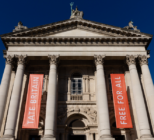Tate, along with the Plus Tate network of affiliated museums and galleries, has urged Boris Johnson’s new government to ensure all children have access to visual art through an “arts-rich curriculum”.
Visual art, it insists, must be a core part of the national curriculum in primary and secondary schools across the country. Additional funding for the arts premium must also be implemented as a matter of urgency, according to the gallery group.

“Access to the visual arts in this country must not depend on social and economic advantage,” Maria Balshaw, director of Tate, asserts. “Private schools place a premium on a rich cultural education for their pupils while many state schools are starved of the resources to support access to culture and creativity for their pupils.
“We need a level cultural playing field for all children because we want and need visually literate adults. There should be fair access to arts in line with the offer to pupils in Scotland and Wales where the arts are already a core commitment.”
Tate has been hosting Steve McQueen’s Year 3 project, which has welcomed more than 600 schoolchildren every day. 1,504 schools are part of the initiative – including State, Independent, Faith and Special schools, Pupil Referral Units and home educated children – and Tate has vowed to do all it can to support these children receive a good quality arts education; despite many of them having “little opportunity” to take art when they enter Key Stage 3.

“The curriculum needs to be big enough to include all subjects and be for all children. Art and creativity are so important to science, to maths, or to any other academic venture,” McQueen stated.
“Cutting arts education means you cut off inventiveness which impacts on being creative. We have many great artists, great thinkers and inventors in the UK and this has come through a sense of possibility. Arts education gives that sense of possibility. I hope Year 3 will spark opportunities for long-term creativity.”

Cultural Learning Alliance figures highlight a sharp decline in school pupils studying arts subjects in England over the past decade. Since 2010 there has been a 35% drop in the uptake of arts GCSE subjects and a 24% slump for A Levels.
Following the conclusion of Tracking Arts Learning and Engagement, a research project run by RSC, Tate and the University of Nottingham, recommendations were made for all secondary schools to ensure that the arts have parity with other subjects at Key Stage 3 and that a full range of arts subjects at Key Stage 4 be available for pupils to select.
“Hard-working teachers are too often thwarted in their aspiration to provide an arts-rich education by the restriction of the curriculum and the dire lack of resources,” Balshaw concludes. “We want to ensure that all schools involved in Year 3 have what they need to deliver access to the arts for this and future generations.”










